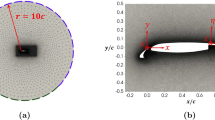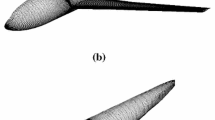Abstract
The flow in the near-field wake region of a generic transport aircraft configuration has been studied using both unsteady RANS and delayed detached-eddy simulations. The NASA Common Research Model has been used for this purpose, as experimental data obtained with this model in the cryogenic European Transonic Wind Tunnel during the ESWIRP test campaign were available for comparison and validation. Focusing on high angles of attack of \(\alpha = 16^\circ\) and \(\alpha = 18^\circ\), the results form the basis for the study of flow phenomena occurring at stall conditions. Such flight conditions are characterized by massive flow separation at the wing and highly unsteady flow in the wake. In a first step, the numerical results are compared with available test data using global force coefficients and pressure distributions on the wing. Both show a good agreement of numerical and experimental results, indicating slight deviations of the pressure variable at the inboard wing sections. In a second step, the turbulent structures of the near-field wake are examined using the proper orthogonal decomposition method based on snapshots (two-dimensional instantaneous flow fields). Frequencies of the first mode-pair match the dominant frequencies of the lift and velocity wake spectra very well.














Similar content being viewed by others
Notes
Data available online at http://www.eswirp.eu [retrieved 2016].
References
Cordier, L., Bergmann, M.: Proper orthogonal decomposition: an overview (2003). http://www.sciencedirect.com/science/article/pii/S008207847780444X
Cordier, L., Bergmann, M.: Two typical applications of POD: coherent structures eduction and reduced order modelling (2003)
Deck, S.: Zonal-detached-Eddy simulation of the flow around a high-lift configuration. AIAA J. 43(11), 2372–2384 (2005). doi:10.2514/1.16810
Frederich, O.: Numerische simulation und analyse turbulenter Strömungen am Beispiel der Umströmung eines Zylinderstumpfes mit Endscheibe. Ph.D. thesis, Technische Universität Berlin, Berlin (2010)
Gansel, P.P., Dürr, P., Baumann, M., Lutz, T., Krämer, E.: Influence of meshing on flow simulation in the wing-body junction of transport aircraft
Gansel, P.P., Illi, S.A., Krimmer, S., Lutz, T., Krämer, E.: Unsteady CFD simulation of the NASA common research model in low speed stall. In: High Performance Computing in Science and Engineering 13, pp. 439–453. Springer, Berlin (2013). http://springer.longhoe.net/chapter/10.1007/978-3-319-02165-2_30
Gansel, P.P., Illi, S.A., Lutz, T., Krämer, E.: Numerical simulation of low speed stall and analysis of turbulent wake spectra. In: 15th International Conference on Fluid Flow Technologies, Budapest, Hungary (2012)
Hefer, G.: ETWA facility for high Reynolds number testing. In: IUTAM Symposium Transsonicum IV, pp. 157–164. Springer (2003). http://springer.longhoe.net/chapter/10.1007/978-94-010-0017-8_25
Hendrickson, B., Leland, R.: The Chaco users guide: version 2.0. Tech. rep., Technical Report SAND95-2344, Sandia National Laboratories (1995)
Lumley, J.L.: The structure of homogeneous turbulent flow. Atmospheric turbulence and radio wave propagation, pp. 166–178 (1967)
Lutz, T.: Going for experimental and numerical unsteady wake analyses combined with wall interference assessment by using the NASA CRM-model in ETW. American Institute of Aeronautics and Astronautics (2013). doi:10.2514/6.2013-871
Lutz, T., Gansel, P.P., Waldmann, A., Zimmermann, D.M., Schulte am Hülse, S.: Prediction and measurement of the common research model wake at stall conditions. J. Aircraft 53(2), 501–514 (2016). doi:10.2514/1.C033351
Rivers, M., Hunter, C., Campbell, R.: Further investigation of the support system effects and wing twist on the NASA common research model. AIAA paper 3209, 2012 (2012). http://arc.aiaa.org/doi/pdf/10.2514/6.2012-3209
Rivers, M.B., Dittberner, A.: Experimental investigations of the NASA common research model. J. Aircraft 51(4), 1183–1193 (2014). doi:10.2514/1.C032626
Schwamborn, D., Gerhold, T., Heinrich, R.: The DLR TAU-code: recent applications in research and industry. In: ECCOMAS CFD 2006: Proceedings of the European Conference on Computational Fluid Dynamics, Egmond aan Zee, The Netherlands, September 5–8, 2006. Delft University of Technology; European Community on Computational Methods in Applied Sciences (ECCOMAS) (2006). http://repository.tudelft.nl/view/conferencepapers/uuid:59162917-d24d-4f11-955f-feaeaa21e2c1/
Sirovich, L.: Turbulence and the Dynamics of Coherent Structures Part I: Coherent Structures. pp. 561–571. Brown University (1987)
Spalart, P., Allmaras, S.: A one-equation turbulence model for aerodynamic flows. American Institute of Aeronautics and Astronautics (1992). doi:10.2514/6.1992-439
Vassberg, J.C., DeHaan, M.A., Rivers, S.M., Wahls, R.A.: Development of a common research model for applied CFD validation studies. AIAA paper 6919, 2008 (2008). http://arc.aiaa.org/doi/pdf/10.2514/6.2008-6919
Vassberg, J.C., Tinoco, E.N., Mani, M., Levy, D., Zickuhr, T., Mavriplis, D.J., Wahls, R.A., Morrison, J.H., Brodersen, O.P., Eisfeld, B., others: Comparison of NTF experimental data with CFD predictions from the 3rd AIAA CFD drag prediction workshop. AIAA paper 6918, 2008 (2008). http://arc.aiaa.org/doi/pdf/10.2514/6.2008-6918
Waldmann, A., Gansel, P.P., Lutz, T., Krämer, E.: Unsteady wake of the NASA common research model in low-speed stall. J. Aircraft, 1–14 (2015). doi:10.2514/1.C033413
Acknowledgements
The ESWI\(^{\text {RP}}\) project and the measurements were funded by the European Commission in the 7th framework program. We are grateful to NASA (M. Rivers, R. Wahls, and their team) for providing the Common Research Model for the test campaign in the European Transonic Wind Tunnel. Besides that, the research was partly funded within LuFo IV ProWinGS (ATLAS). The authors gratefully acknowledge the support and the computational resources which were provided by the High Computing Center Stuttgart. The simulations were performed on a CRAY XE 40 which is funded by Federal Ministry of Education and Research and the Ministry of Higher Education, Research and Arts Baden-Württemberg.
Author information
Authors and Affiliations
Corresponding author
Ethics declarations
Conflict of interest
The authors declare that they have no conflict of interest.
Additional information
This paper is based on a presentation at the CEAS Air and Space Conference 2015, September 7–11, Delft, The Netherlands.
Rights and permissions
About this article
Cite this article
Zimmermann, DM., Waldmann, A., Lutz, T. et al. Development of flow structures in the near-field wake region of the Common Research Model. CEAS Aeronaut J 9, 347–359 (2018). https://doi.org/10.1007/s13272-016-0222-3
Received:
Revised:
Accepted:
Published:
Issue Date:
DOI: https://doi.org/10.1007/s13272-016-0222-3




